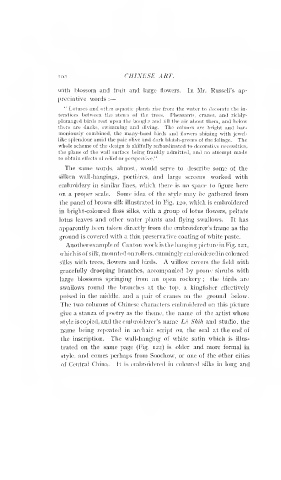Page 352 - Chinese Art, Vol II By Stephen W. Bushell
P. 352
102 — CHINESE ART.
with blossom and fruit and large flowers. In Mr. Russell's ap-
preciative words :
" Lotuses and other aquatic plants rise from the water to decorate the in-
terstices between the stems of the trees. Pheasants, cranes, and richly-
plumaged birds rest upon the boughs and fill the air about them, and below
there are ducks, swimming and diving. The colours are bright and har-
moniously combined, the many-hued birds and flowers shining with jewel-
like splendour amid the pale olive and dark bluish-greens of the foliage. The
whole scheme of the design is skilfully subordinated to decorative necessities,
the plane of the wall surface being frankly admitted, and no attempt made
to obtain' effects of relief or perspective."
The same words, almost, would serve to describe some of the
silken wall-hangings, portieres, and large screens worked with
embroidery in similar lines, which there is no space to figure here
on a proper scale. Some idea of the style may be gathered from
the panel of brown silk illustrated in Fig. 120, which is embroidered
in bright-coloured floss silks, with a group of lotus flowers, peltate
lotus leaves and other water plants and flying swallows. It has
apparently been taken directly from the embroiderer's frame as the
ground is covered with a thin preservative coating of white paste.
Another example of Canton work is the hanging picture in Fig. 121,
which is of silk, mounted on rollers, cunningly embroidered in coloured
silks with trees, flowers and birds. A willow covers the field with
gracefully drooping branches, accompanied by peony shrubs with
large blossoms springing from an open rockery ; the birds are
swallows round the branches at the top, a kingfisher effectively
poised in the middle, and a pair of cranes on the ground below.
The two columns of Chinese characters embroidered on this picture
give a stanza of poetry as the theme, the name of the artist whose
style is copied, and the embroiderer's name Lfi Shih and studio, the
name being repeated in archaic script on the seal at the end of
the inscription. The wall-hanging of white satin which is illus-
trated on the same page (Fig. 122) is older and more formal in
style, and comes perhaps from Soochow, or one of the other cities
of Central China. It is embroidered in coloured silks in long and

